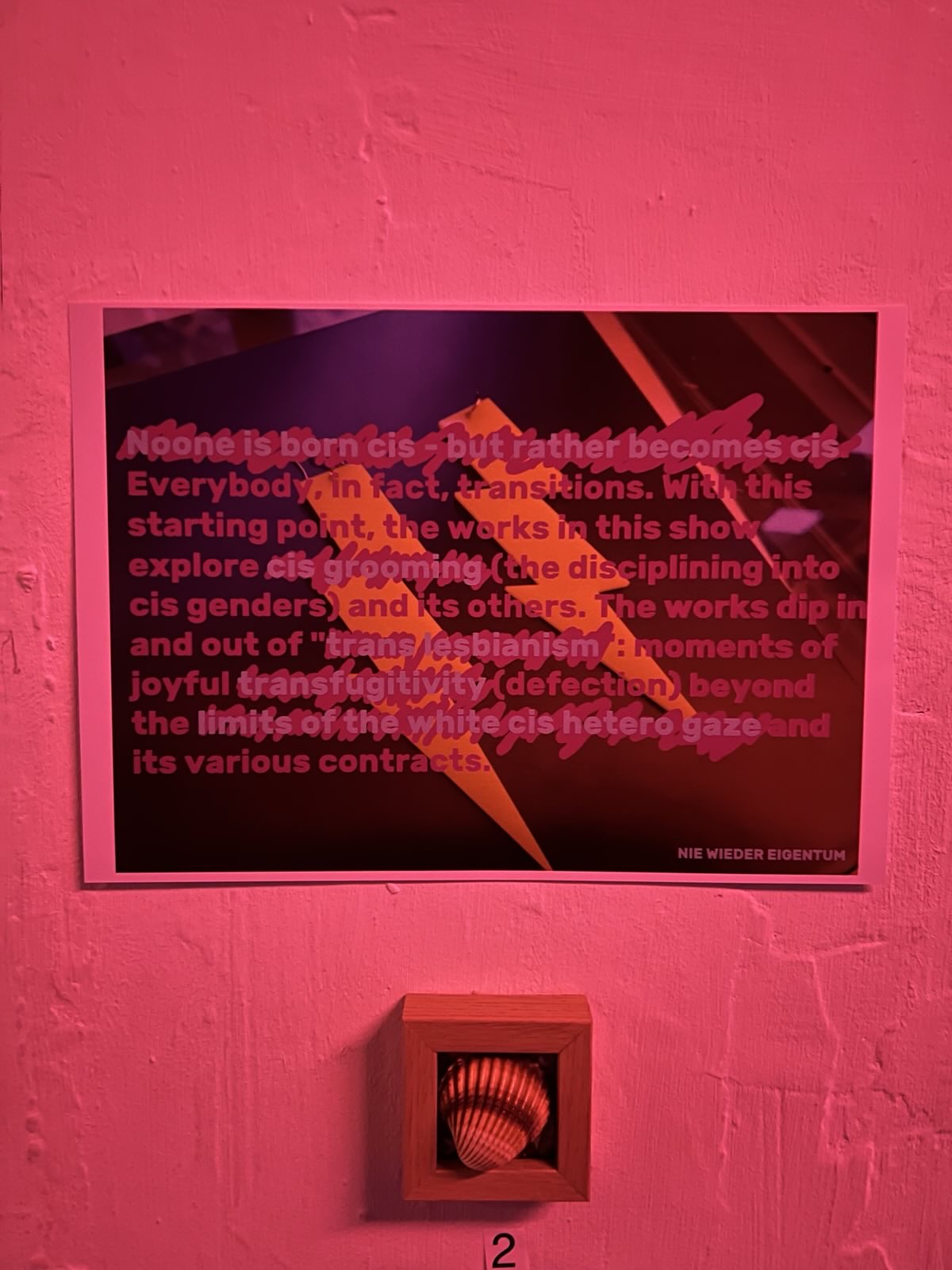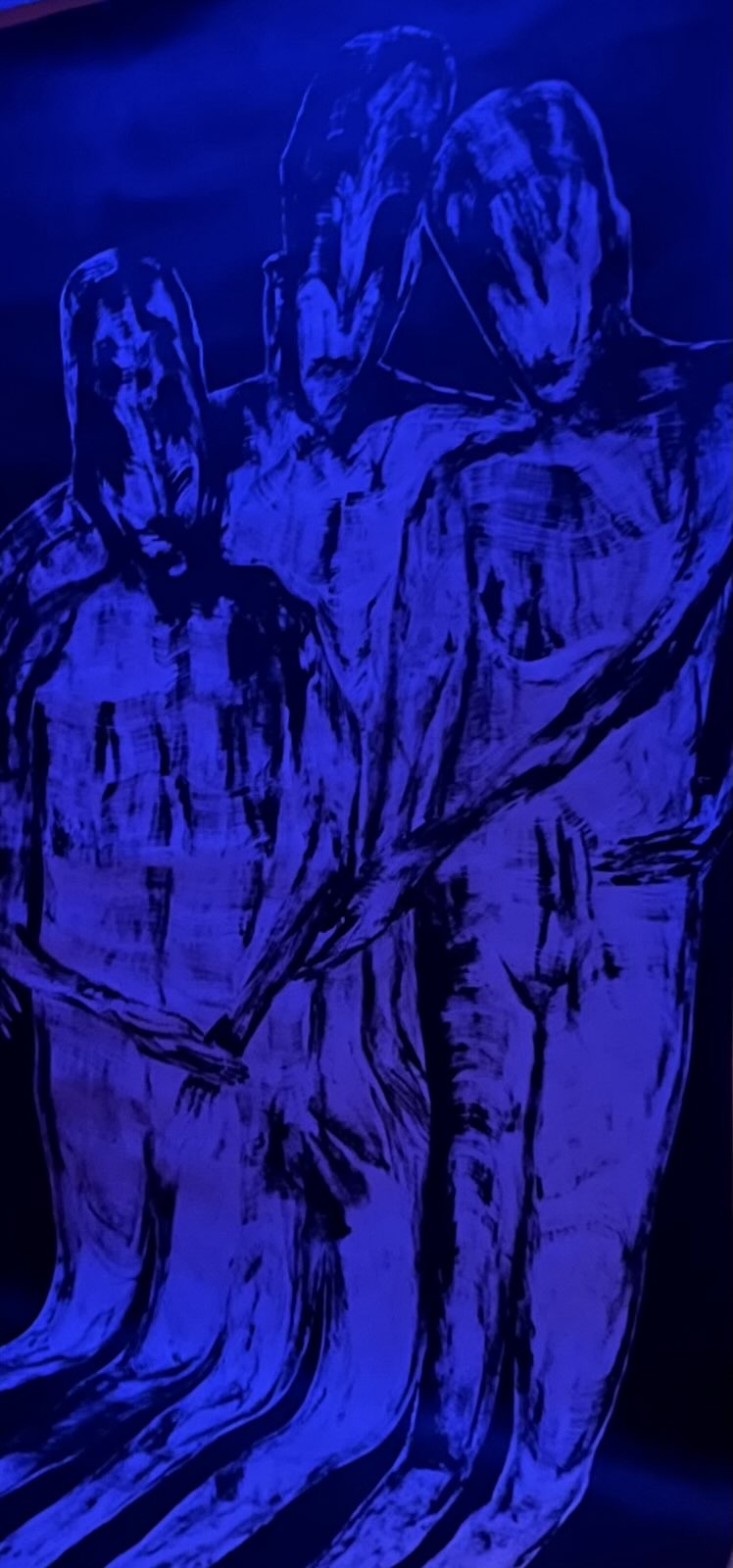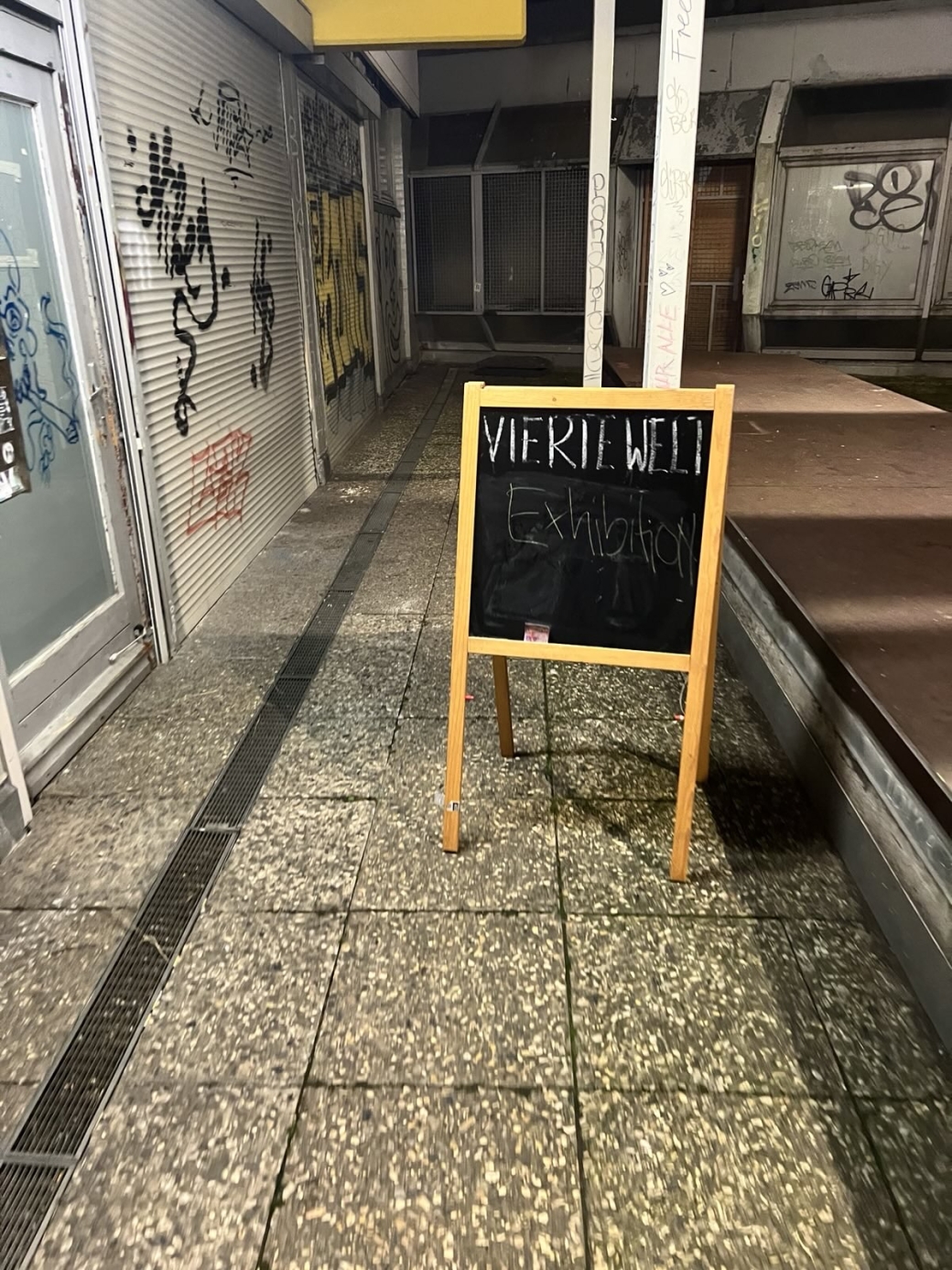no one has to be cis
an exhibition review
The political present for queers is icy – even less hospitable than Berlin in February – and while spring has arrived on a meteorological level as I am doing the last corrections for this text, politically it seems hardly in sight. Now, I want to write about an event that has carved a space of cozy hospitality out of both, the freezing time and place. From 6th to 8th of February, Vierte Welt, a small space for independent theater, performance, art and discourse at Kottbusser Tor hosted the exhibition The Trans Lesbian Response – A Self Portrait with contributions of several artists, writers, activists and thinkers. The exhibition suggested a broad and radical understanding of transitions, their theoretical and political implications and potentials with a delightful disregard to pathologizing, reactionary or strategically relativizing narratives towards trans people and transitions. Especially in times when western-centric (if not colonial) progress-narratives are once more proven insufficient by the circular temporality of reactionary politics (amongst other things), this exhibition opened a desperately needed perspective. Unapologetic, home-cooked, and a little bit messy, this exhibition created lines of flight that might help us avoid getting stuck in reactive politics of damage control or legal rearguard actions, whose framework can only be limited to a defense of (trans) rights and the liberal state that grants or denies them. Instead, The Trans Lesbian Response opened up space for radical imaginaries – for reimagining gender and desire, the relation of Cis and Transness as broad social and political questions, intimately tied to queries about ownership, property and the society we want to live in.1
I enter Vierte Welt through an unremarkable glass door, a small chalk-sign announces the space and an «ExhibitioN» – hopefully the one I have been looking for – and I am immediately welcomed by Luce deLire, one of the contributing artists/writers who also (co-)curated the The Trans Lesbian Response. Standing in the dim light that the pink fluorescent tubes above us bathe the room in, I learn that I’m welcome to just linger and hang out in the space for how long and wherever I want. There is a small cart with drinks for the visitors and plenty of space to sit or lie down. The living-room atmosphere doesn’t quite catch on to me at first though – I wonder whose space I’m moving or maybe trespassing in while slowly wandering around the exhibition, that spreads out through the maybe 100 square meters of Vierte Welt.
The center of the room attracts my attention, there is a (video) installation containing a plastic (maybe latex) covered bed, surrounded by boxes, a miniature artificial fireplace and small items that I can’t quite make out from the distance. But instead of entering this installation I focus on artworks that surround the potentially intimate and prominently exposed space: The middle of the room is contained by four white pillars that showcase Andrea Illés’ large digital prints Feeling Love 1–3. If I were to pick one quality that dominates these pictures, it would be movement. Up and down, into, out of and within the frame that holds images of bodies, or rather schemes and forms of fleshy pink, movement happens. The deliberate blurriness of the pictures obscures and abstracts these bodies and their movement (from where, to where?) to a certain degree and highlights movement itself as that which can only partly be captured by these digital pictures. The works enticingly achieve to be pixelated and fleshy at the same time, combining the aesthetic of long-time exposure photography and digital image processing. Still I’m seeing bodies here, naked bodies, some with dark hair, one of them wearing (red) high heels? Pictures of bodies, pictures of and in (e-)motion, in transition, in love, if we follow their title, at the same time underdetermined and speaking of a very concrete materiality. They are intense, not gentle, but gracious, possibly erratic, maybe even euphoric, showing themselves off and refusing to be captured – or at least categorized, identified. Combining opacity and corporeality the series Feeling Love captures what cannot be pinned down, as it moves in and through a body, towards others – or maybe oneself? If this feeling of love is characterized in movement, in change, maybe it is love of and for these bodies in transition themselves.

The Trans Lesbian Response, exhibition view, photo: PH
An affirmative approach towards transition is one of the core principles of the exhibition. Printed out wall-texts describe «moments of joyful transfugitivity» to be found in trans- lesbianism. Cisness is suggested not so much as a norm from which transness is the deviation and even less a biological or social certainty, but as a discipling system that we are «groomed» into. Trans Lesbianism, another text claims, is not to be restricted «to trans people who are also lesbians», but «encompasses all transitions, trans, cis, non-binary and beyond», it can even offer «fugitivity from the transsexual contract».2
In a remarkable interplay with the exhibited art works these short texts employ the topoi of transphobic-moral panics to extend our understanding of gender and desire. Trans-Lesbianism, the very specter of TERF-consciousness and the scapegoat of right-wing anti-trans rhetoric with its bathroom-bills, defamatory talk of sexual education and lived gender diversity as «child-grooming», is mobilized not so much as an identity-category, but rather as a welcoming realm of refuge and joy. From this perspective trans people, specifically trans-lesbians, appear less as the ones who need to be rescued but rather like creators and providers of resources for resistance: They carved trans-lesbianism out of the fabric of reality to enable emancipation from the chokehold of Cisness. The promise of stability, consistency, coherence, that Cisness implies and the privileges that are connected to it, comes into view as a set of prohibitions against (self-)transformation.

no one is born cis, exhibition view, photo: PH
Conveying the conceptual framework of The Trans Lesbian Response, these texts connect to an ongoing contestation of the foundations of the cis/trans distinction and its jurisdictional realization in Germany, that the action group Selbst Bestimmung Selbst Gemacht (SBSG), which some of the participants of the exhibition engage in, has been involved in for quite some time. In one of the corners of Vierte Welt I find a computer that is playing the podcast Queerocracy Now! It is part of an ongoing project by the group who describes itself as «mostly concerned with trans, inter*, non-binary politics» and became especially active within the scope of the so called «Selbstbestimmungsgesetz». SBSG formulated their very own alternative to the (while certainly an improvement to the status quo) widely criticized law passed by the German Bundestag in November 2024 and continue their political work with a variety of guests on their podcast, among other endeavors.3 On the SBSG’s homepage, I am greeted again by a version of Andrea Illés’ Feel Love, accompanied by the sentence. «Die Geschlechter denen, die drin wohnen!»,4 an appropriation of well-known chants for a right to housing and squatting. Trans issues are for SBSG not to be separated from other social and economic questions, the analogization of gender and property suggests a form of materialist tranfeminist critique that resonates through all the site’s texts, especially a manifesto-like «serving suggestion». There are many paths to follow on this site and many relations to explore between SBSG’s work more broadly and The Trans Lesbian Response – especially on the question of property-gender relation, their potential abolition. 5 Due to my limited space I want to emphasize one concept which connects to my reading of the series Feeling Love above: «Geschlechtliche Euphorie» or «gender euphoria».
While the term, especially its English version, is by no means new – for example the brilliant Olympia Bukkakis used it as a title of one of her earlier performances6 and it seems to have made the rounds in certain fields of research on trans experience in the last couple of years –7 the action group SBSG coins it in a very autonomous and politicized manner:
Geschlechtliche Euphorie ist die uneingeschränkte Freude an der eigenen Begehrbarkeit. Geschlechtliche Euphorie ist eine positionierte Unbestimmtheit, ein immerwährendes Mehr, eine Uneingeschränktheit, die in vielerlei Richtungen bereist werden kann. Das Versprechen der Transgeschlechtlichkeit an alle Menschen – trans, inter, nicht-binär und cis und alle anderen – ist dieses: Die eigene Geschlechtlichkeit, das Verhältnis zum Begehren der anderen, kann ein Grund zur Freude sein. Darin lebt bereits das Versprechen der Queerokratie: Dass alle sich gemeinsam aneinander und an sich selbst erfreuen können, ungeachtet aller Normierung.8
The text breathes a social and political understanding of gender and transitions. It defies every form of (psycho-)pathological, individualizing argumentation. Dysphoria is no longer the symptom of a medical condition, but an attribute of society which is in itself and as a whole dysphoric because of structural fears: fears of rejection, not to be desired, not to pass. Gender euphoria and an affirmative, wide understanding of transitions – while connected to concrete political demands considering (trans) health care, self-determination and reparation – are an attempt not to ‹heal› individuals, but to transform the social. This is by no means a call for mere happiness, the exclusion of ambivalence or ‹bad› feelings. A cut-out paper mask of German far-right politician Alice Weidel, that lies next to the podcast station, reminds me of the political present this exhibition takes place in – one that threatens to roll back even the limited self-determination that was won.

Ulaş, Family Portrait (2024), exhibition view, photo: PH
On the other side of the room ambivalence and negative experiences are transformed into art works in the contributions of CallaZ, who collects, annotates, and exhibits, among other things, letters of rejections in different forms and media. A little further Michelle Alexander exhibits unpublished manuscripts, many of them were created by overwriting preexisting texts to poetry of death and survival. Processes of erasure and marking become medium and subject. Most striking for me, however, is another part of the exhibition that has already caught my eye when I entered Vierte Welt. To my right I see a rather gloomy corner, a big panel of fabric is hanging from the ceiling, distinctly separating this space from the rest of the room. Once I step behind the panel, I realize that the light and the mood changes, a cold blue illuminates the backside of the panel, it was used as a canvas. I am standing in front of Family Portrait (2024), a more than life size painting by Ulaş. White on black, three figures are looking down on me as I lay down on a beanbag facing the painting, the exhibition-room opening up behind it. There is something ghostlike to them, uncanny, a little spooky even. Their knees bend the wrong way where the fabric meets the ground, laying out their calves and feet on the ground while the rest of their bodies rise straight upwards. Their hands cross, reaching towards each other’s arms, shoulders, crotches, an erected penis is visible on the right, but most of the rest is a blur. Corresponding to Andrea Illés’ work but set in a totally different tonality and medium, this family portrait also encapsulates movement of bodies – among themselves but maybe also within each other: heads, legs, chests, genitals. No form stands still. The hard and unsteady lines on the black surface remind me of the digital prints’ blurredness and, at the same time, of the style of woodcuts. Described as a «ghostly family affair – an impossible step beyond unwritten contracts» in the handout accompanying the exhibition, Ulaş work plays with sexual desire around and of taboos: Family Portrait implies a violation of the – especially for cis-heterosexual societies – legally and morally foundational principle of incest prohibition. What kind of family are these three schemes that are looking down on me while fumbling and feeling each other? Who or what am I in relation to them in this dimly lit corner? A voyeur? An invited visitor? A potential family-extension? The painting fascinates me and makes me feel a little uncomfortable, watched, I feel expectations (‘their’ expectations or mine?), excitement and discomfort. Beyond the aesthetic connection there’s another link between this portrait and the affirmations of transition: It couldn’t care less for respectability politics, but plays with the specters trans people and transitions are made into.
This text ends with gratitude for the hospitality of trans-lesbianism that was opened by this exhibition – both, in the concrete space of Vierte Welt and in the generous conception of the term. There would be more to write about: the interactive installation by Annett Hardegen and Luce deLire, Making Trans Save For Cis People – Or Not, that invites me to sit down on the latex-covered bed in the exhibition’s center and watch a video of more or less naked bodies (or body-parts) moving and touching each other, the painted brooches by Elizabeth Kaizer, the (Music-)Videos by CallaZ … Maybe there’ll be a chance for other people to do so. The exhibition is happy to travel if they are invited, Luce deLire tells me when I leave Vierte Welt. I can only encourage other institutions to do so. Focusing on the desire, joy and desirability in transition as a social and political process The Trans Lesbian Response – A Self Portrait opens up a horizon that reaches far beyond the narrow corridors of the disturbing and harmful reality that is ‹realistic politics›. In the face of international right-wing disruption this exhibition offers an alternative to the politically depressing search for the lowest democratic denominator. The radicality of tos insight and message, that no one has to be cis, lies in its reformulation of a fundamental political and social question: How do we want to live together?
- 1
Maybe the exhibition is part of something that Simon Strick and Johanna Schaffer so rightfully claimed on this blog a couple of weeks ago: resistance against the dullness and authoritarian impulses of our present (media landscape): Schaffer, Johanna; Strick, Simon: Radikale Einfallslosigkeit. (Grundlage und Effekt gegenwärtiger Konsensproduktion). In: Zeitschrift für Medienwissenschaft, ZfM Online, GAAAP_ The Blog, 2. Februar 2025, https://zfmedienwissenschaft.de/online/radikale-einfallslosigkeit.
- 2
As I learned later Luce deLire, who I met when I entered the exhibition is the author of theses texts. They are bits and pieces of her theoretical work on the relation of transness, social contracts and the (im-)possibility of self-determination in our current political and economic present. As important as deLire’s theoretical work might be for the exhibition, I will focus on the space I entered before knowing too much about it – also to avoid any foolish attempt at squeezing her complex and comprehensive theoretical endeavor into this little text. For further glimpse into deLires conception of the transsexual contract – a persuasive translation of Monique Wittig’s heterosexual contract – see Luce deLire & SBSG’s contribution to the C3-conference: Trans Lesbianism at 38c3, YouTube, 31.3.2025, https://www.youtube.com/watch?v=753ZbMdS8Rc&ab_channel=EvilPhilosophy (22.4.2025). For some reflections on the term transsexuality and its appropriation see also Luce deLire, Nature is a Transsexual Woman – Lucretian metaphysics reconsidered, in: Classical Philology Bd. 119, Nr. 2, 2024, https://doi.org/10.1086/729837. For the implications of this trans-theory concerning psychoanalysis see Luce deLire, Transsexuality at the Origin of Desire. Or, Schreber’s Satanic Handjob, in: Vanessa Sinclair, Elisabeth Punzi, Myriam Sauer (Hg.): The Queerness of Psychoanalysis. From Freud and Lacan to Laplanche and Beyond, London 2024, pp. 111-148.
- 3
Selbst Bestimmung Selbst Gemacht (SBSG), homepage of the collective: https://queerokratia.de/ (22.4.2025).
- 4
«Genders belong to those who live (in) them!», loosely translated, PH.
- 5
Besides investigations in the relation of gender and property-relation in the face of abolition (and what that would mean for gender euphoria or dysphoria) it might be of interest to discuss the resonances and differentiations between SBSG’s and other attempts at materialist trans critique, for example: Jules Joanne Gleeson/Elle O'Rourke (Hg.), Transgender Marxism. London 2021; Emma Heaney (Hg.), Feminism Against Cisness, Durham, London, 2024.
- 6
Olympia Bukkakis, Gender Euphoria: Drag as a Construction Site for New Gender Realities, Performance, January 2019, https://olympiabukkakis.com/works/gender-euphoria:-drag-as-a-construction-site-for-new-gender-realities/ (22.4.2025).
- 7
In Anglo-American sexuality studies and connected fields the term seems a lot more common than in German speaking academia – especially since 2022 there are several publications that seem to explore its potential and meanings. However, they hardly seem as productively depathologizing and politicizing it as Bukkakis oder SBSG: The Trevor Project (non-profit org.), The Trevor Project. Gender Euphoria Among Transgender and Nonbinary Young People, 2023, https://www.thetrevorproject.org/research-briefs/affirming-actions-and-gender-euphoria-among-transgender-and-nonbinary-young-people/ (22.4.2025); Ashley Austin/Ryan Papciak/Lindsay Lovins, Gender euphoria: a grounded theory exploration of experiencing gender affirmation, in: Psychology & Sexuality, Volume 13, Nr. 5, 2022, pp. 1406–1426. https://doi.org/10.1080/19419899.2022.2049632; Shoshana Rosenberg/Damien W. Riggs/Salem Skelton, The Trans Möbius Strip. Gender Dysphoria Meets Gender Euphoria, Palgrave Macmillan, Cham 2024. Seit kurzem gibt es zudem eine, an der Berliner Universitätsallianz in der Psychologie angesiedelte Student-Research Group mit zum Thema: «Gender euphoria in trans and non-binary adolescents«: https://www.ewi-psy.fu-berlin.de/psychologie/arbeitsbereiche/klinische_kinder_jugend_psy_und-kinder_psytherapie/forschung/geschlechtsidentitaet_inkongruenz_dysphorie/gender_euphoria/index.html [Projektseite] (22.4.2025).
- 8
«Gender euphoria is the uninhibited joy in the face of one’s own desirability. Gender euphoria is a situated indeterminacy, it’s always more, a boundlessness to be traversed in many ways. Transness is a promise to all people – trans, inter, non-binary, cis and beyond – that one’s own gender as a relation to the desires of others can be a source of joy. This already includes the promise of queerocracy: We can all enjoy each other and ourselves despite all normativation.» (translation PH), https://queerokratia.de/wp-content/uploads/2024/11/Queerokratia-Ein-Serviervorschlag.pdf (22.4.2025).
Bevorzugte Zitationsweise
Die Open-Access-Veröffentlichung erfolgt unter der Creative Commons-Lizenz CC BY-SA 4.0 DE.
